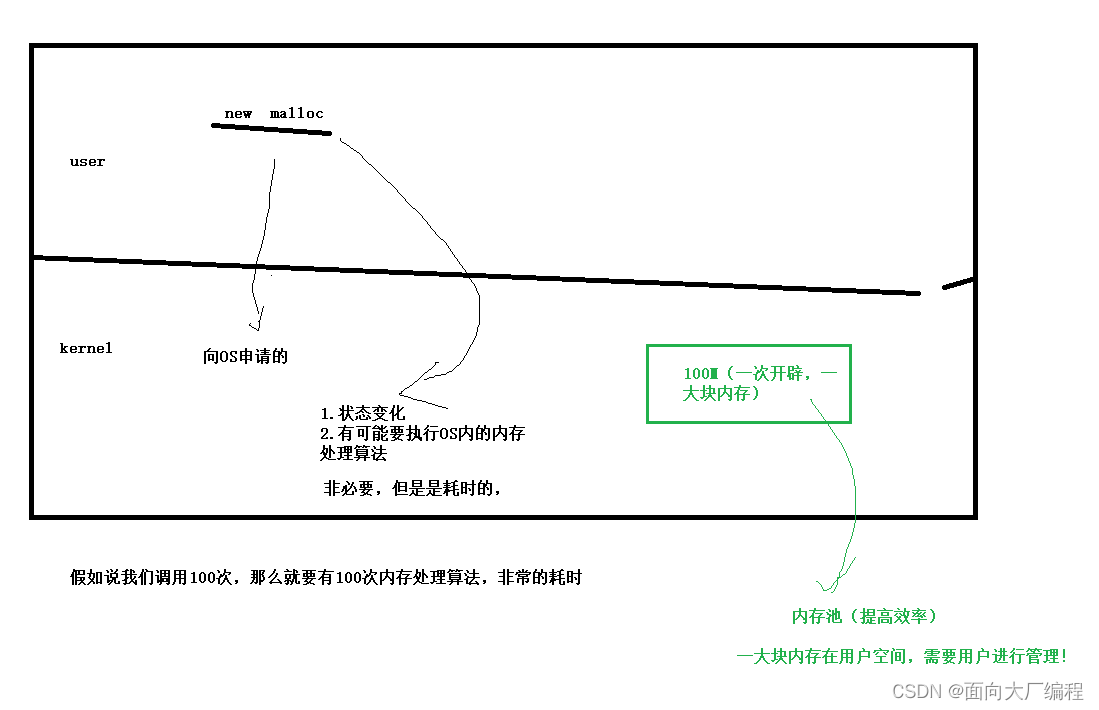文章目录
原理

如我们每次动态开辟一个变量空间的时候,都会有效率的损失,如果有一个内存池,需要的化直接在里面取就行了,这就大大的提高了效率
当我们创建任务的时候再去申请线程,就相当于我们需要malloc的时候再去申请空间,创建线程也是有成本的,
请求来了,线程要提前准备好,任务来了,就指派给他
提前准备好的线程,原来随时处理任务就叫做线程池
(提高效率)
实现
Task.hpp
使用这个Task类,将此作为里面的类型
Task.hpp
1
2
3
4
5
6
7
8
9
10
11
12
13
14
15
16
17
18
19
20
21
22
23
24
25
26
27
28
29
30
31
32
33
34
35
36
37
38
39
40
41
42
43
44
45
46
47
48
49
50
51
52
53
54
55
56
57
58
59
60
61
62
63
64
65
66
67
68
69
70
| #pragma once
#include <iostream>
#include <pthread.h>
namespace ns_task
{
class Task
{
private:
int _x;
int _y;
char _op;
public:
Task()
{
}
Task(int x, int y, char op)
: _x(x), _y(y), _op(op)
{ }
~Task()
{
}
int Run()
{
int res = 0;
switch (_op)
{
case '+':
res = _x + _y;
break;
case '-':
res = _x - _y;
break;
case '*':
res = _x * _y;
break;
case '/':
res = _x / _y;
break;
case '%':
res = _x % _y;
break;
default:
std::cout << "bug?" << std::endl;
break;
}
std::cout << "当前任务正在被:" << pthread_self() << "处理:" << _x << _op << _y << "=" << res << std::endl;
return res;
}
Task operator=(Task &s)
{
if (this != &s)
{
_x = s._x;
_y = s._y;
_op = s._op;
}
return *this;
}
int operator()()
{
return Run();
}
};
}
|
threadpool.hpp
实现线程池类,高封装性,将所有的对于线程的操作都放在这个类里面是实现
1
2
3
4
5
6
7
8
9
10
11
12
13
14
15
16
17
18
19
20
21
22
23
24
25
26
27
28
29
30
31
32
33
34
35
36
37
38
39
40
41
42
43
44
45
46
47
48
49
50
51
52
53
54
55
56
57
58
59
60
61
62
63
64
65
66
67
68
69
70
71
72
73
74
75
76
77
78
79
80
81
82
83
84
85
86
87
88
89
90
91
92
93
94
95
96
97
98
99
100
101
102
103
104
105
106
107
108
109
110
111
112
113
114
115
116
117
118
119
120
121
122
123
124
| #pragma once
#include <iostream>
#include <string>
#include <queue>
#include<unistd.h>
#include<pthread.h>
namespace ns_threadpool
{
const int g_num=5;
template <class T>
class ThreadPool
{
private:
int num_;
std::queue<T> task_queue_;
pthread_mutex_t mtx_;
pthread_cond_t cond_;
public:
ThreadPool(int num=g_num) :num_(num)
{
pthread_mutex_init(&mtx_,nullptr);
pthread_cond_init(&cond_,nullptr);
}
~ThreadPool()
{
pthread_mutex_destroy(&mtx_);
pthread_cond_destroy(&cond_);
}
static void* Rountine(void* args)
{
pthread_detach(pthread_self());
ThreadPool<T>* tp=(ThreadPool<T>*)args;
while(true)
{
tp->Lock();
while(tp->IsEmpty())
{
tp->Wait();
}
T t;
tp->PopTask(&t);
tp->UnLock();
t.Run();
sleep(1);
}
}
void InitThreadPool()
{
pthread_t tid;
for(int i=0;i<num_;i++)
{
pthread_create(&tid,nullptr,Rountine,(void*)this);
}
}
void PopTask(T* out)
{
*out=task_queue_.front();
task_queue_.pop();
}
void Wait()
{
pthread_cond_wait(&cond_,&mtx_);
}
bool IsEmpty()
{
return task_queue_.empty();
}
void Lock()
{
pthread_mutex_lock(&mtx_);
}
void UnLock()
{
pthread_mutex_unlock(&mtx_);
}
void Wakeup()
{
pthread_cond_signal(&cond_);
}
void PushTask(const T & in)
{
Lock();
task_queue_.push(in);
UnLock();
Wakeup();
}
};
}
|
main.cc
非单例模式
1
2
3
4
5
6
7
8
9
10
11
12
13
14
15
16
17
18
19
20
21
22
23
24
25
26
27
28
29
30
31
32
33
34
|
#include"threadpool.hpp"
#include"Task.hpp"
#include<unistd.h>
#include<cstdlib>
#include<ctime>
using namespace ns_task;
using namespace ns_threadpool;
int main()
{
ThreadPool<Task>* tp=new ThreadPool<Task>();
tp->InitThreadPool();
srand((long long)time(nullptr));
while(true)
{
Task t(rand()%20+1,rand()%10+1,"+-*/%"[rand()%5]);
tp->PushTask(t);
}
return 0;
}
|
详细代码可以查看
ThreadPool
